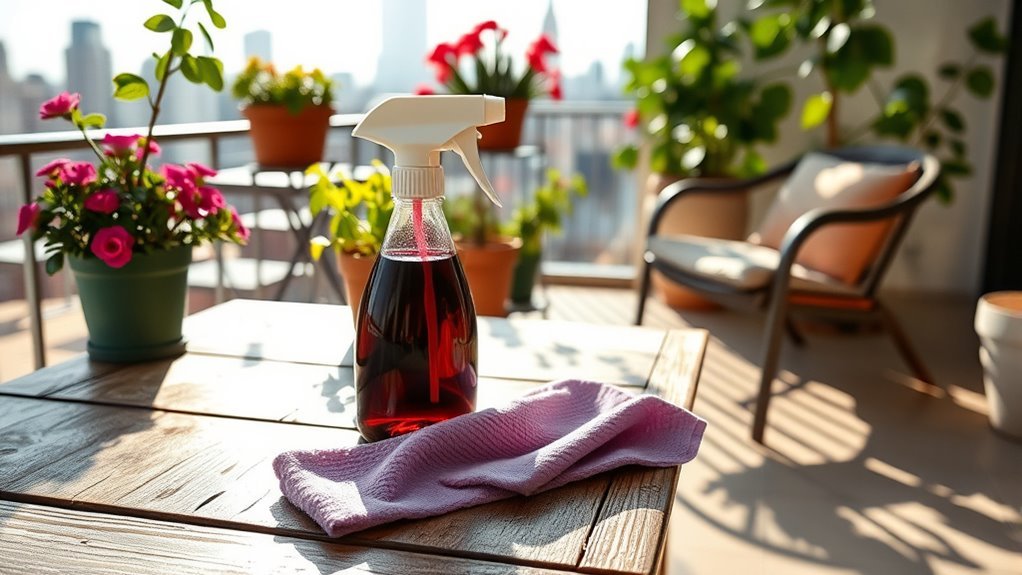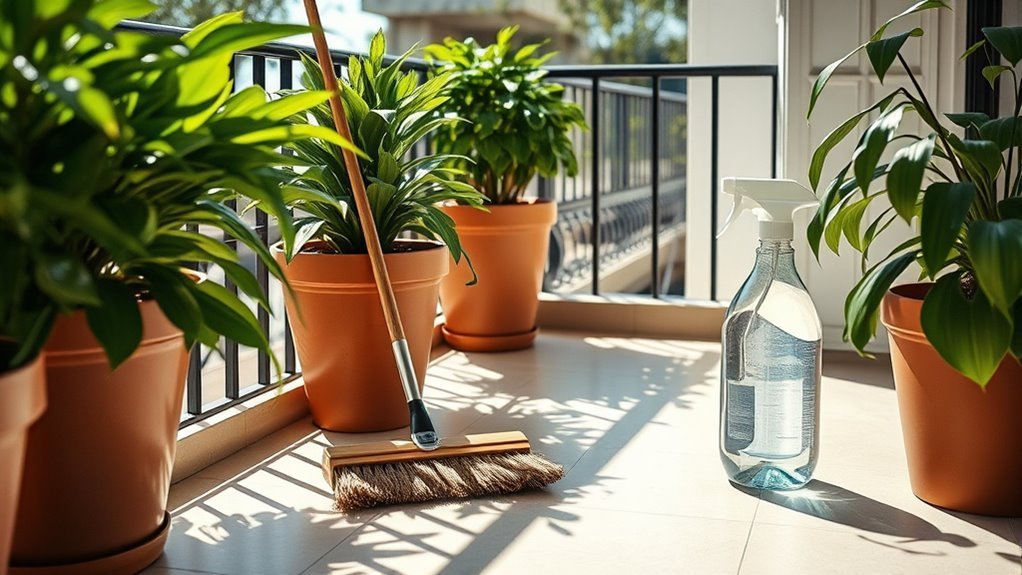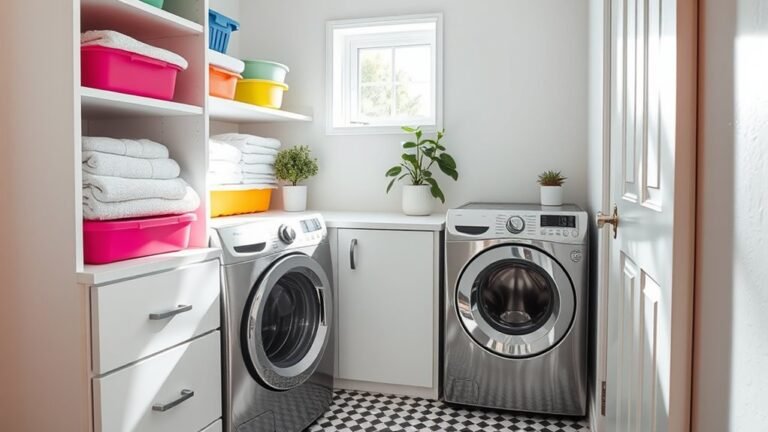Best Way to Sanitize Your Balcony
The best way to sanitize your balcony starts with evaluating its condition and clearing debris. Gather eco-friendly disinfectants, gloves, and brushes for safe cleaning. Remove furniture and plants, then sweep thoroughly. Use a natural sanitizer like vinegar or hydrogen peroxide, applying evenly and letting it sit before rinsing. Don’t forget to wipe down outdoor furniture and pots regularly. Follow these steps, and you’ll create a fresh, healthy space. Keep exploring to discover more tips on maintaining your balcony’s hygiene and safety.
Assessing Your Balcony’s Cleaning Needs

How do you know what kind of cleaning your balcony really needs? Start by examining the balcony condition closely. Is there accumulated dirt, dust, or even mold? The level of grime will guide your approach. If your balcony is exposed to heavy pollution or frequent rain, it’ll demand more regular attention. Consider the cleaning frequency that fits your lifestyle and environment—weekly if you enjoy open-air freedom often, or monthly if it’s more occasional. Don’t ignore overlooked spots like corners or railings where grime tends to build up. By honestly evaluating your balcony’s current state, you empower yourself to choose a cleaning routine that matches your desire for a fresh, inviting space. This way, your balcony remains a true extension of your free, vibrant living.
Gathering Essential Sanitizing Supplies
Before you start, make sure you have the right cleaning agents like disinfectant sprays and all-purpose cleaners. Don’t forget to grab protective gear such as gloves and a mask to keep yourself safe. Having these supplies ready will make the sanitizing process smoother and more effective.
Must-Have Cleaning Agents
Although sanitizing your balcony can seem straightforward, having the right cleaning agents makes all the difference in achieving a thorough and effective clean. To truly enjoy your outdoor space without worry, you’ll want to stock up on essential tools like a sturdy scrub brush and a spray bottle for easy application. When it comes to cleaning agents, eco friendly options are the way to go—not only do they protect the environment, but they’re also safer for you and any plants nearby. Look for biodegradable disinfectants and natural degreasers to tackle dirt and germs without harsh chemicals. Choosing these smart, effective products lets you maintain a fresh balcony while staying true to your free-spirited lifestyle.
Protective Gear Essentials
Three key pieces of protective gear will make sanitizing your balcony safer and more comfortable. First, focus on gloves selection—choose durable, waterproof gloves that fit well to protect your hands from harsh chemicals while allowing freedom of movement. Next, don’t overlook the mask importance; a quality mask shields you from inhaling fumes or airborne particles, keeping your lungs safe as you work. Finally, consider wearing protective eyewear to prevent any splashes from irritating your eyes. By gearing up properly, you maintain your independence and peace of mind, tackling sanitation without risking your health. With these essentials, you can confidently refresh your balcony space, knowing you’re well-protected and ready for a thorough, safe clean.
Preparing the Balcony Surface for Cleaning

Before you start cleaning, make sure to clear away all debris from your balcony surface. Pick cleaning agents that are effective but safe for your materials and plants nearby. Also, take a moment to inspect the area for any damage that might need attention before sanitizing.
Clear Debris Thoroughly
Clearing debris is an essential first step in preparing your balcony for cleaning. You want to enjoy your outdoor space without any clutter holding you back. Start by gathering all loose leaves, dirt, and trash using simple debris removal techniques like sweeping with a sturdy broom or using a handheld vacuum. For stubborn dirt in corners, a brush or cloth can help you reach those tight spots. Consider balcony clutter solutions to organize or temporarily relocate furniture and potted plants, giving you clear access to every surface. This not only makes cleaning easier but also sets the stage for a thorough sanitizing process. By tackling debris early, you free your balcony to become a clean, inviting oasis where you can truly relax.
Choose Safe Cleaning Agents
Once you’ve cleared away all debris, the next step is selecting cleaning agents that won’t harm your balcony surfaces or the environment. Opt for eco friendly options that offer effective cleaning without harsh chemicals. These choices respect your freedom to maintain a safe, healthy space while minimizing environmental impact. Avoid bleach or strong solvents that can damage materials or release toxic fumes. Instead, look for products labeled biodegradable or plant-based, which guarantee chemical safety for you and your neighbors. You can also create your own mild cleaners using vinegar, baking soda, or mild soap mixed with water. By choosing safe cleaning agents, you protect your balcony’s integrity and enjoy peace of mind knowing you’re making responsible, empowered decisions for your outdoor sanctuary.
Inspect for Damage
Although it might be tempting to dive straight into cleaning, you should first inspect your balcony for any damage. Take a close look at the floor, railings, and walls for signs of balcony wear like cracks, rust, or loose tiles. Addressing these issues before cleaning guarantees you don’t worsen any problems or compromise your safety. Checking the structural integrity is vital—it’s your foundation for enjoying a worry-free outdoor space. If you spot damage, consider repairs or consult a professional. By doing this, you protect your balcony and yourself, allowing you to clean freely without stress. This step sets the stage for effective sanitizing and keeps your balcony a secure, inviting retreat you can truly enjoy.
Choosing the Right Sanitizing Solutions

When selecting sanitizing solutions for your balcony, you’ll want to assess both effectiveness and safety. Choosing eco friendly options lets you protect your space without harmful chemicals, preserving your freedom to enjoy a clean, healthy environment. Look for effective disinfectants that kill germs but won’t damage surfaces or irritate your skin. Natural ingredients like vinegar, hydrogen peroxide, or essential oils can be powerful alternatives to harsh chemicals. Keep in mind, some commercial products offer fast, reliable sanitation but may contain toxins—so always check labels and opt for greener brands when possible. By picking the right balance between potency and eco-consciousness, you maintain a safe, inviting balcony where you can relax worry-free. Your choice supports both your wellbeing and the planet’s health.
Step-by-Step Balcony Cleaning Process
After choosing the right sanitizing solutions, you’re ready to tackle the actual cleaning. Free your balcony from dirt and grime to fully enjoy your outdoor space. Follow these steps:
- Remove all balcony decor and outdoor furniture to clear the area.
- Sweep the floor thoroughly to get rid of dust, leaves, and debris.
- Apply your chosen sanitizer using a mop or spray, ensuring even coverage, then let it sit as directed before rinsing.
This simple process lets you reclaim your balcony as a clean, inviting retreat. You’ll feel the freedom of a fresh space to relax or entertain, knowing it’s hygienic and welcoming. Keep your balcony spotless to truly enjoy the open air without worry.
Dealing With Stubborn Stains and Mold
If you’ve noticed stubborn stains or mold lingering on your balcony, don’t worry—it’s a common issue that can be handled effectively with the right approach. Start by tackling stain removal with a mixture of water and mild detergent or a specialized cleaner designed for outdoor surfaces. Use a scrub brush to gently lift the stains without damaging your balcony’s finish. For mold prevention, apply a solution of diluted white vinegar or a commercial mold remover, ensuring you reach all the affected areas. After cleaning, let your balcony dry completely to discourage mold growth. Taking these steps not only frees your space from unsightly marks but also helps maintain a healthy, inviting atmosphere where you can enjoy your freedom without worry.
Maintaining a Clean Balcony Regularly
Handling stubborn stains and mold is just one part of keeping your balcony inviting. To truly enjoy your outdoor space freely, maintaining cleanliness regularly is key. Here’s how you can keep your balcony fresh and welcoming:
- Sweep and Wash Weekly: Remove dirt and debris from your balcony floor and outdoor furniture to prevent buildup.
- Tend to Balcony Plants: Trim dead leaves and wipe down pots to avoid attracting pests and mold.
- Protect Outdoor Furniture: Use covers or clean surfaces with mild detergent to extend their life and keep them looking sharp.
Tips for Enhancing Balcony Hygiene and Safety
While keeping your balcony clean is essential, focusing on hygiene and safety guarantees it remains a healthy and secure space. Start by regularly wiping down your outdoor furniture with a mild disinfectant to prevent dirt buildup and germs. Don’t forget to trim and care for your balcony plants; overgrown or decaying foliage can attract pests and mold. Make certain pots have proper drainage to avoid standing water, which breeds bacteria. Securely fasten furniture and railings to prevent accidents, especially if you enjoy a breeze-filled, open space. Finally, store cleaning supplies and gardening tools neatly to avoid clutter, reducing trip hazards. By combining cleanliness with smart safety habits, you’ll create a balcony that’s both inviting and worry-free, letting you enjoy your freedom outdoors without compromise.
Frequently Asked Questions
Can I Use Natural Disinfectants Instead of Chemical Sanitizers on My Balcony?
Did you know that vinegar can kill up to 82% of bacteria on surfaces? If you’re wondering about natural disinfectant options for your balcony, you’re in luck. While they’re gentler and eco-friendly, their effectiveness comparison to chemical sanitizers varies—natural ones like vinegar and tea tree oil work well but may not eliminate all pathogens. If you want freedom from harsh chemicals, they’re a great choice, just don’t expect hospital-level sterilization.
How Often Should I Sanitize Balcony Furniture Compared to the Floor?
For balcony maintenance, you’ll want to sanitize your furniture more often than the floor since it’s touched frequently. Aim for cleaning furniture weekly to keep germs at bay and preserve furniture care. The floor can be sanitized biweekly or after heavy use. This balance lets you enjoy your outdoor space without constant fuss, giving you freedom to relax while keeping everything fresh and safe.
Are There Specific Sanitizing Methods for Wooden Versus Tiled Balconies?
Did you know wood surfaces can absorb moisture up to 20% more than tiles, making sanitizing methods essential? When cleaning wooden balconies, you’ll want to use a gentle wood treatment to avoid damage and maintain surface protection. For tiled balconies, a mild disinfectant or diluted bleach works well without harming the finish. Choosing the right method lets you freely enjoy your space without worrying about wear or germs.
Can Sanitizing My Balcony Help Reduce Allergens in Outdoor Air?
Absolutely, sanitizing your balcony can help reduce allergen sources like pollen, dust, and mold that settle on surfaces. By doing regular outdoor cleaning, you’re not only keeping your space fresh but also minimizing what gets stirred up into the air when you enjoy your balcony. This means you can breathe easier and truly relax outside without those pesky allergens cramping your style. So, it’s a simple way to reclaim your freedom outdoors!
Is It Safe to Use Bleach-Based Products Near Plants on the Balcony?
Imagine a splash of bleach seeping into your plant’s soil, threatening its vibrant green leaves. When it comes to bleach safety, you’ll want to keep these harsh chemicals away from your balcony’s plants to protect their health. Bleach can damage roots and stunt growth, so it’s best to sanitize hard surfaces carefully, avoiding drips or overspray. That way, you can enjoy a clean space without sacrificing your plants’ freedom to thrive.






